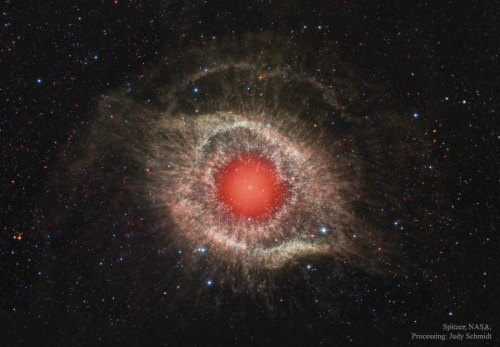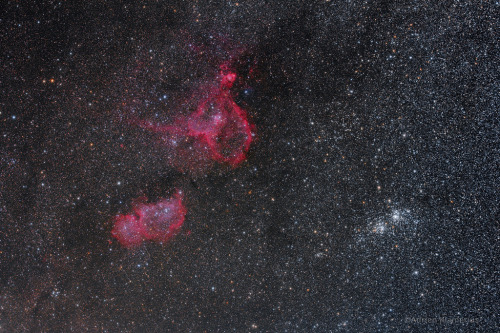Weirdtalesanduniverse-blog - Weird N' Wide Universe

More Posts from Weirdtalesanduniverse-blog and Others

Space cat

Clouds of Jupiter

Helix Nebula // NGC 7293

IC 1805 & IC 1848 // Heart & Soul Nebulae (left)
and
NGC 869 & NGC 884 // h & Chi Perseii // The Double Cluster (right)

Few stars are visible such as the Andromeda galaxy. But the majority of the stars that you can observe with the naked eye are in this small area of the Milky Way.



fucking milky way


The beautiful Andromeda Galaxy is often imaged by planet Earth-based astronomers. Also known as M31, the nearest large spiral galaxy is a familiar sight with dark dust lanes, bright yellowish core, and spiral arms traced by blue starlight. A mosaic of well-exposed broad and narrow-band image data, this colorful, premier portrait of our neighboring island universe offers strikingly unfamiliar features though, faint reddish clouds of glowing ionized hydrogen gas in the same wide field of view. Still, the ionized hydrogen clouds likely lie in the foreground of the scene, well within our Milky Way Galaxy. They could be associated with the pervasive, dusty interstellar cirrus clouds scattered hundreds of light-years above our own galactic plane. If they were located at the 2.5 million light-year distance of the Andromeda Galaxy they would be enormous, since the Andromeda Galaxy itself is 200,000 or so light-years across.
Image Credit &Copyright:Rogelio BernalAndreo(Deep Sky Colors)
Time And Space
-
 harmonicgamingangel22blog liked this · 6 years ago
harmonicgamingangel22blog liked this · 6 years ago -
 16fahri liked this · 6 years ago
16fahri liked this · 6 years ago -
 f-lorenzo liked this · 6 years ago
f-lorenzo liked this · 6 years ago -
 theproblemswiththesky liked this · 6 years ago
theproblemswiththesky liked this · 6 years ago -
 uday9574-blog liked this · 6 years ago
uday9574-blog liked this · 6 years ago -
 mmuehlfeld-blog liked this · 6 years ago
mmuehlfeld-blog liked this · 6 years ago -
 kingragnarok25 reblogged this · 6 years ago
kingragnarok25 reblogged this · 6 years ago -
 kingragnarok25 liked this · 6 years ago
kingragnarok25 liked this · 6 years ago -
 atilla4434sblog liked this · 6 years ago
atilla4434sblog liked this · 6 years ago -
 realtonystark liked this · 6 years ago
realtonystark liked this · 6 years ago -
 lumosnite liked this · 6 years ago
lumosnite liked this · 6 years ago -
 talizoravonnormandy liked this · 6 years ago
talizoravonnormandy liked this · 6 years ago -
 theworldismyoysterandiamthepearl liked this · 6 years ago
theworldismyoysterandiamthepearl liked this · 6 years ago -
 whisperersworld liked this · 6 years ago
whisperersworld liked this · 6 years ago -
 fagdykefrank liked this · 6 years ago
fagdykefrank liked this · 6 years ago -
 ancienthare liked this · 6 years ago
ancienthare liked this · 6 years ago -
 tyyiyi liked this · 6 years ago
tyyiyi liked this · 6 years ago -
 themosthairiestlobsterintheworld liked this · 6 years ago
themosthairiestlobsterintheworld liked this · 6 years ago -
 uvlight-catzzz liked this · 6 years ago
uvlight-catzzz liked this · 6 years ago -
 smallfryingpan liked this · 6 years ago
smallfryingpan liked this · 6 years ago -
 daemondamian liked this · 6 years ago
daemondamian liked this · 6 years ago -
 giorgioooo-blog1 liked this · 6 years ago
giorgioooo-blog1 liked this · 6 years ago -
 dani-glz-maltes liked this · 6 years ago
dani-glz-maltes liked this · 6 years ago -
 cryptomosquito liked this · 6 years ago
cryptomosquito liked this · 6 years ago -
 o-deadan liked this · 6 years ago
o-deadan liked this · 6 years ago -
 midwest-apples liked this · 6 years ago
midwest-apples liked this · 6 years ago -
 abodeglued liked this · 6 years ago
abodeglued liked this · 6 years ago -
 jester-toon-rabbit liked this · 6 years ago
jester-toon-rabbit liked this · 6 years ago -
 plaudiusplants liked this · 6 years ago
plaudiusplants liked this · 6 years ago -
 majinyaj liked this · 6 years ago
majinyaj liked this · 6 years ago -
 galaticangel liked this · 6 years ago
galaticangel liked this · 6 years ago -
 ajc18615425 liked this · 6 years ago
ajc18615425 liked this · 6 years ago -
 otwashi liked this · 6 years ago
otwashi liked this · 6 years ago -
 theslavicnord reblogged this · 7 years ago
theslavicnord reblogged this · 7 years ago -
 starlovely liked this · 7 years ago
starlovely liked this · 7 years ago -
 vboilingr-blog liked this · 7 years ago
vboilingr-blog liked this · 7 years ago -
 vboilingr-blog reblogged this · 7 years ago
vboilingr-blog reblogged this · 7 years ago -
 dannoyerw-blog liked this · 7 years ago
dannoyerw-blog liked this · 7 years ago
66 posts